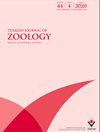文章标题黑海地区Halyomorpha halys (stastal, 1855)(半翅目:蝽科)分布及种群密度
IF 1.7
4区 生物学
Q2 ZOOLOGY
引用次数: 2
摘要
褐纹臭蝽(Brown marmorated臭虫,Halyomorpha halys)是一种多食性入侵害虫,其传播和危害随着全球商业活动的增加而增加。本研究继2018年入侵黑海地区后,分别于2019年、2020年和2021年调查了该害虫的传播、种群密度和变化情况,并对可能的传播原因和采取的措施进行了评价。在黑海沿岸8个省的141、120和162个地点设置了信息素诱捕器,对种群过程进行了监测。在阿尔特温省和里泽省的所有地点都发现了高人口密度。由于人口交往继续在格鲁吉亚边界附近发生,该地区大约98%的人口居住在这两个省。阿特温省周平均种群水平为7.36只/架,日则省为9.11只/架;害虫继续从东向西蔓延,在一些地方发现了不规则和相隔较远的地方种群。结果表明,它对榛子、猕猴桃、柑橘、玉米和豆类等不同寄主造成种群密度依赖型经济危害。本研究考察了halys在泰国的种群分布、与之相关的潜在问题、传播途径以及可能的解决方案。本文章由计算机程序翻译,如有差异,请以英文原文为准。
Distribution and population density of Halyomorpha halys (Stål, 1855) (Hemiptera: Pentatomidae) in Black Sea Region of Türkiye
: Brown marmorated stink bug (BMSB), Halyomorpha halys , is a polyphagous invasive pest whose spread and damage are increasing with global commercial activities. In this study, following the invasion of Black Sea Region in 2018, spread, population density and change of the pest were investigated in the years 2019, 2020, and 2021, possible causes of spread and measures to be taken were evaluated. Course of population was monitored with pheromone traps placed in 141, 120, and 162 locations in 8 provinces along the coastline of Black Sea Region. High population density was detected at all locations of Artvin and Rize provinces. Since the population interactions continued near the Georgian border, about 98% of the total population in the region was seen in these two provinces. Weekly average population level was 7.36 adults/traps in Artvin and 9.11 adults/traps in Rize Province; spread of the pest continued from east to west and irregular and further-apart local populations were detected at some points. It was determined that it caused population density-dependent economic damage on different hosts including hazelnut, kiwi, citrus, maize and beans. This research examined the H. halys population distribution in Türkiye, potential problems associated to that too, ways that it spreads, and possible solutions.
求助全文
通过发布文献求助,成功后即可免费获取论文全文。
去求助
来源期刊

Turkish Journal of Zoology
ZOOLOGY-
CiteScore
2.30
自引率
10.00%
发文量
24
审稿时长
6-12 weeks
期刊介绍:
The Turkish Journal of Zoology is published electronically 6 times a year by the Scientific and Technological Research Council of Turkey (TÜBİTAK).
-Accepts English-language manuscripts in various fields of zoology including systematics, developmental biology, behaviour biology, animal models, molecular biology and molecular phylogeny, genomics, physiology (cell communication and signaling systems), biochemistry and immunohistochemistry, applied parasitology and pathology, nanobiotechnology, ecology, evolution, and paleontology of animal taxa.
-Contribution is open to researchers of all nationalities.
-Short communications are also welcome, such as reports of a preliminary nature or those including new records from specific localities or regions, and the editor reserves the right to decide that a paper be treated as a short communication.
-The papers that deal with purely checklists, new host and non-regional new locality records will not be consider for publication.
-Letters to the editor reflect the opinions of other researchers on the articles published in the journal. The editor may also invite review articles concerning recent developments in particular areas of interest.
 求助内容:
求助内容: 应助结果提醒方式:
应助结果提醒方式:


